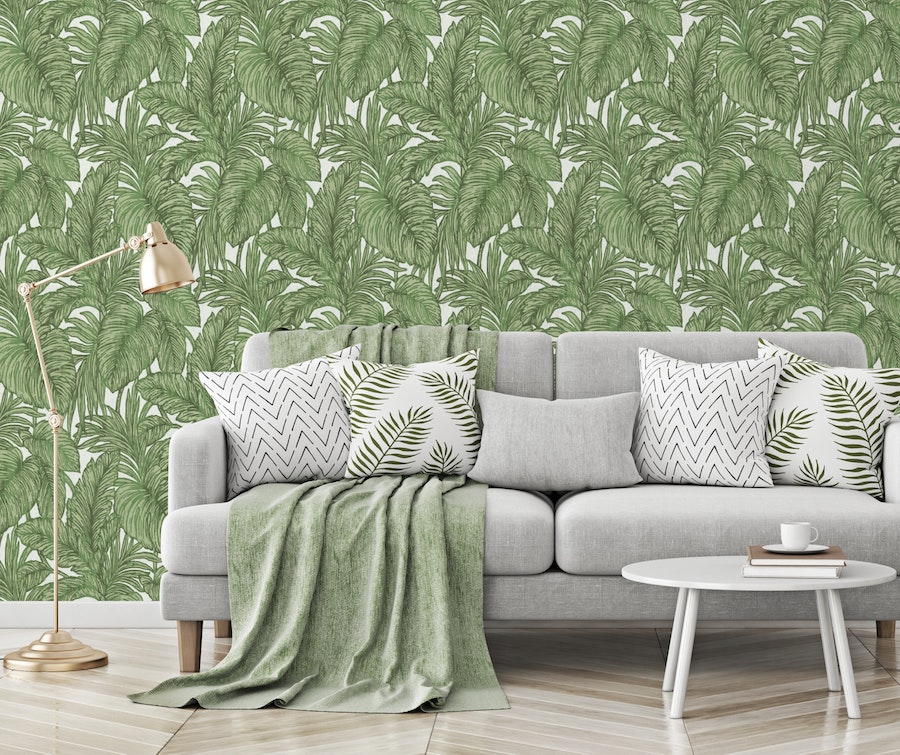15 expert tips for removing and putting up wallpaper
It may sound daunting but even a first-timer can wallpaper like a pro with the right prep and patience.
Sick of staring at the same old walls? Then why not give them a bright new look by wallpapering them?
Putting up wallpaper – either throughout a room or just on a single feature wall – is a great way to introduce personality into your home or update decor, as there’s a huge variety of colours and patterns available. Wallpaper can help hide uneven walls, small dimples and imperfections too, and is generally cheaper and easier than replastering.
“If you’re new to wallpaper then the thought of tackling the job yourself can feel a little overwhelming, but it’s actually really easy to hang,” insists Alex Whitecroft, head of design at I Want Wallpaper. “As with any job, preparation is key. Taking time to strip and prep walls properly will make sure you end up with a professional finish, plus there are some tricks of the trade that will help.
“If you’re nervous about using patterns, try a feature wall while you find your feet,” she adds. “They’re still a huge trend in interiors and will provide a focal point in the room.”
Keen to know more? Here are Whitecroft’s tips for stripping and hanging new wallpaper…
1. Check the existing paper
It’s important to know what’s underneath existing wallpaper. Use a scraper to test how many layers of paper there are. The best paper to remove is ‘strippable paper’ and most vinyl wallpapers are strippable – a smooth texture on the back will indicate this.
Check how easy the paper’s going to be to remove by using a knife to pry away a corner of the paper, then pull it down at an angle. If it peels away in a long strip, with no signs of adhesive underneath, the task is a lot easier. To make wallpaper even easier to remove next time, add an acrylic primer to the wall.
2. Prep like a pro
It’s important to protect floors, woodwork and furniture, and it’s also good practice to remove wall sockets if possible. Cover any gaps with tape to stop water getting in, and turn the electricity off to be extra safe. If you can’t remove furniture, then move it to the centre of the room and cover it with a sheet.
To do the job properly you’ll need: A ladder, wallpaper scraper, utility knife, spray bottle, liquid soap/detergent, a sponge, tape, old sheets and rubber gloves.
3. Give it a good soak
For non-strippable wallpaper, make a number of slits around 10-inches apart in the paper with a utility knife, being careful not to damage the wall underneath. Use a sponge to wet the wall with a mixture of warm water, a small amount of cellulose paste and liquid detergent. Adding slits allows moisture to soak behind the wallpaper, making removal much easier, and creates strips to guide removal strokes.
4. Scrape away
Once the paper’s soaked for a few minutes, start to scrape it off with a wallpaper scraper. Slide behind the slits, holding the blade at a 30-degree angle, slowly scraping the paper upwards, away from the wall.
5. Removing well-stuck wallpaper
Steamers can be used for more stubborn papers – they’re slightly messier than the slit and soak method, but if wallpaper’s stubborn, they’ll get the job done.
Alternatively, try fabric softener – it softens both the glue and the paper, making the job much easier. Mix equal parts of softener and hot water in a spray bottle, and spray a section of wallpaper until it’s saturated. Wait around 15 minutes to allow the solution to work its magic, then peel away the paper, using a paint scraper on stubborn areas.
6. Removing wallpaper paste
There may be residue or traces of glue left on the wall, which can be removed with a solution of washing-up liquid, a tablespoon of baking soda, vinegar and hot water. Again, apply with a sponge. The solution should soften the glue or paste, so it’s easy to wipe away with a rag. Use a putty knife or similar scraping tool to remove any remaining paste.
7. Prepare to paper
Once the wall’s dried thoroughly, patch any holes with a joint compound (a creamy material available from DIY stores). Once dry, use sandpaper to create a smooth surface.
8. Make sure you’ve bought enough paper for the space
Buy wallpaper in consecutive batch numbers, so the paper matches up perfectly. Accurately measure the area that needs to be covered and slightly over-order to allow for mishaps. Over-ordering is also necessary if you’ve chosen patterned paper, so you can match up the pattern repeat.
9. Tool up
You’ll need a pasting table, stepladder, a bucket, a paint roller and tray, pasting brush, a seam roller (a tool that helps seal edges without marking surfaces), a wallpaper smoother (a flexible plastic tool to smooth wallpaper and remove air bubbles), a spirit level/plumb line to make sure you hang wallpaper straight, pushpins, a steel tape measure, pencil, scissors, a large scraper and a utility knife.
10. Again, it’s all in the prep
‘Size’ the wall by covering it in a mixture of half PVA glue and half water applied with a paint roller. It’s not essential, but this will create a slightly glossy finish to the wall and make it easier to slide paper into position and help it stick.
11. Get it straight
Use the plumb line to draw straight lines at regular intervals around the room.
Measure the floor to ceiling height of the room and make a mark on your pasting table – this saves time measuring each piece of paper individually. Allow a few extra inches for variations in height within the room – especially in old houses where floors and ceilings can be uneven – and to make sure you have adequate paper to line up the pattern repeat.
12. A good pasting
Some pastes can remove the finish of wallpaper, especially delicate papers, so check you have the right paste for your paper. A wheat base is gentle and suitable in most cases. To apply paste, lay a strip of paper flat on the table and level with the edges, weigh down each end and spread on the paste evenly. Fold the paper in a concertina to carry it safely to the wall.
13. Line it up
It’s important to get the first length straight, as this sets the template for the rest of the room, so use those straight pencil lines you’ve already drawn as a guide.
14. Work outwards
If your paper has a large pattern, then start in the middle of the wall or at a focal point in the room and work outwards – again, you’ll need to measure the mid-point in your wall. For plains or small pattern repeats, begin papering from the corner of the room, ideally on a wall with no windows or doors so you can hang full lengths without any problem. And make sure each sheet of paper is the right way up!
15. Overlap and trim
Apply the paper to the wall, allowing some overlap at the ceiling, and then trim it. Don’t worry if your first attempt’s wonky, you can manoeuvre your sheets to get them into the perfect spot as the paste won’t dry immediately. Repeat with further strips and ensure the pattern lines up. Smooth the paper so there are no air bubbles and voila – you’ve wallpapered like a pro!
The Press Association
Latest posts by The Press Association (see all)
- Which type of ISA is right for you now the new tax year has started? - April 20, 2024
- Beatles documentary Let It Be to be released on Disney+ - April 16, 2024
- How to keep your money safe – as criminals ramp up AI tactics to steal consumer data - April 16, 2024
- Seasoned marathon runners give their best race day tips for first-timers - April 16, 2024
- What are heat pumps and could they help your home save energy? - April 15, 2024





















